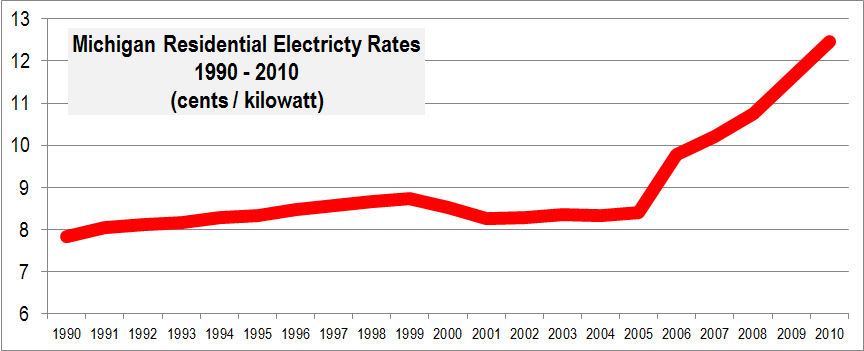

Home Page |
MICHIGAN FORESTS FOREVER
TEACHERS GUIDE
 |
Bringing It All Home |
|
Wood Energy Curriculum for High School Classrooms
This wood energy curriculum module is divided into five sections. Each section has a set of exploration topics to help guide students through an aspect of energy, energy use, and the role of woody biomass. Some materials are provided but, more important, resources are included for development of additional materials.
1 - Big Energy
2 - Wood Energy
3 - Environmental Aspects
4 - Socio-Economic Aspects
5 - Bringing It All Home
Bringing It All Home
The United States has about 320 million people, and the number is slowly growing. All of the things that we do, and all of the things that we use, require raw materials and energy. All of these things come from natural resources that need to be extracted, processed, distributed, and (usually) disposed of. The collective behavior of millions has huge implications.
Of course, a single person won’t make a difference. But changed behavior by millions will make a huge difference! There are many examples where collective decisions have important outcomes. Consider road construction costs. Or how schools are funded. Public services? What if all these things had to be paid for exclusively by those who use them?
No single raindrop believes it’s responsible for the flood.
Naturally, most of our current energy sources have limited supplies. They won’t last forever, even though some might last for a long time yet. Current renewable technologies are incapable of replacing fossil fuels. Reducing the difference between supply and demand will require conservation and better efficiencies. We don’t necessarily have to go “without” a bunch of things, but we will need to go about things more intelligently, purposefully, and strategically. Otherwise, it will not likely be possible to avoid a series of crises. Some folks argue that some of these crises are already unavoidable. Others say they’ve already begun . . . at least you might hear this at the gas station.
This fifth section explores answers to 7 questions. These seven questions will likely generate other questions, which would be good to explore.
1. Where is your electricity generated? From what fuel source?
2. How does electricity arrive at your house?
3. How many kilowatts does your home consume in one month? One year?
4. How is your home heated? Where is the source of the fuel?
5. How much total energy does your household consume in a year?
6. What’s the mileage on the vehicle you usually drive?
1. Where is your electricity generated? From what fuel source?
Making electricity available in appropriate quantities at all times of the day and year involves a lot of regulating. Electricity, in mass quantities, cannot be easily stored. It needs to be produced at the same time it is used. Balancing demand and supply is tricky. The demand is called the “load” and varies greatly between day and night, and then over the seasons.
Production data by state can be obtained from the Energy Information Administration. For example, 60% of the electricity generated in Michigan comes from coal, and 26% from nuclear. However, Michigan operates within a larger grid and is a net electricity importer. Generated electricity from multiple sources flows into the grid. So, the electricity we actually use may or may not have been generated in Michigan.
Much of the electricity is generated from large coal-fired utilities, and a fair amount from nuclear. The Pacific Northwest has a lot of hydropower. In some areas, nuclear power is more common. Nowhere is non-hydro renewable electricity a major part of the supply, but it is growing.
U.S. Electricity Generation by Fuel, All Sectors

References
Energy Information Administration. Electricity Data [http://www.eia.doe.gov/electricity]
2. How does electricity arrive at your house?
 The
distribution system is called the “grid”. North America has three major grid
systems, all of which are stressed. There are about a half-million miles of
power lines in the USA . . . and most of them date back more than half a
century. Managing the power in the grid is still rather low tech, which makes
major power failures more likely. The last real big one was in 2003, which
affected over 50 million of people around the Great Lakes and New England. 265
power plants went off-line. Proposals have been made to make the grid ‘smart’
by using digital technology and rapid data feedback.
The
distribution system is called the “grid”. North America has three major grid
systems, all of which are stressed. There are about a half-million miles of
power lines in the USA . . . and most of them date back more than half a
century. Managing the power in the grid is still rather low tech, which makes
major power failures more likely. The last real big one was in 2003, which
affected over 50 million of people around the Great Lakes and New England. 265
power plants went off-line. Proposals have been made to make the grid ‘smart’
by using digital technology and rapid data feedback.
Whenever a new power plant is built or expanded, the connection to the grid becomes an important issue. Are the connections enough to handle the increased amount of power? How will that power get to the people who need it? Does a new power line need to be built? How difficult is that? How much money might be needed?
How hard would it be to trace the power lines from your house to the nearest utility?
What do you lose in your house when the power goes out? Water? Heat? Does your gas furnace use electric regulators or igniters? How about the kitchen stove? How long will your cell phone run without recharging?
How long could you go without power before running into some serious problems?
References
National Geographic Magazine. July 2010. Can we fix the infrastructure that powers our lives?
3. How many kilowatts does your home consume in one month? One year?
Take a look at the monthly electricity bill for your house. How many kilowatts were used? Can you find electricity bills for past months? Does your home usage change between winter and summer? What’s the charge per kilowatt? What other charges are on the bill?
Select a friend or relative in another part of the state or country. Ask them how much they pay per kilowatt . . . and how many kilowatts they consume in a typical month. Compare the prices and usages within your group. Are there big differences? If so, why do you suppose that is so?
How much more per year would your family pay if electricity prices jumped 10 cents per kilowatt? How does that compare to what your family spends on milk? Cigarettes? Eating at restaurants? Clothing? Car payments? Mortgage? Pizza?
4. How is your home heated? Where is the source of the fuel?
How much does it cost to heat your home for a winter? Do you have more than one heat source? A wood stove or fireplace? What quantities of fuel are used (electricity, natural gas, propane/LP, wood, pellets, fuel oil, others)? Where do, geographically, the major sources of coal, petroleum, and natural gas come from . . . that we use in Michigan (or the USA)?
Is your home well-insulated? If not, how much money and fuel could be saved if it were? How much would it cost to get the house well-insulated? How many years of fuel savings would it take to pay for the insulation?
Some people believe wood heat is cheaper than it really is, although it’s still probably the best deal around. A lot of work is expended to build that wood pile. It must be cut from the woods, hauled, bucked, maybe split, and moved around. Without gasoline, how would the truck or chainsaw run? Time can be money. It can also be a pleasant recreational past time for many. A person with more time than money may have a different perspective than someone else with money but little time.

Energy Information Administration
5. How much total energy does your household consume in a year?
How hard might it be to perform a total energy consumption analysis for your house – all forms of energy? Are there companies or agencies in your town that can do energy audits? How much gasoline does your family use in a year? What proportion of your family income is spent on energy? Where do those dollars go? Does your family spend more money on food or energy or housing?
How much more does it cost to build an energy efficient house that has design features that use renewable energy? Probably more than a conventional house. But, how much lower might the annual operating costs be? Over a 50 year period, which is cheaper . . . a cheap house with high operating costs . . . or a more expensive house with low operating costs? What is the least expensive way to heat a house? Does it involve fossil fuels?
Would you consider operating costs when purchasing a house? A car? A household appliance? A large flat screen TV? A hot water heater?
In 2009, the U.S. consumed 94.4 quadrillion btus of energy. The human population was about 305,000,000. That's about 310 million btus per person each year. How much is that? A cord of wood has about 20,000 btus. So, that's about 15,500 cords of wood per person. A gallon of gasoline has about 114,000 btus. So, that's about 2,700 gallons per person. These are simplistic calculations but the quantities provide a tangible amount of our personal energy consumption.

Bureau of Transportation Statistics
6. What’s the mileage on the vehicle you usually drive?
Transportation fuels (gasoline, diesel, ethanol, etc.) are used in mass quantities in the USA. An increasing portion of our consumption comes from regions of the world that are politically unstable. Take a look at the price for a barrel of oil over the past 10-15 years. What’s the price for a barrel of oil today? What might it be in 10 years?
Most of our transportation fuel gets consumed in passenger vehicles. So, the amount of oil we consume is largely a reflection of our collective behavior. How much less petroleum would we need if everyone reduced the number of annual miles traveled by 10 percent? 20 percent? How would you do that? Car pool? Drive less? Use a more efficient vehicle? Do you think about how your behavior might be important?
Build a spreadsheet that shows the cost of fuel over 10 years. Assume 10,000 miles per year and $4.00 per gallon of fuel. Use different mpg figures. What’s the cost difference between 20 mpg and 40 mpg? How does that compare to the cost of the vehicle? How much money would you be willing to spend ‘up-front’ to save more in the long run?
On that spreadsheet, build-in the costs of initial purchase, insurance, and a repair estimate. Figure a car will last ten years. If you ‘buy’ a used car, adjust the spreadsheet accordingly. How much of the monthly cost of a vehicle does fuel account for? How much does the monthly cost of owning and operating a vehicle change when the price of fuel changes by 50 cents? A dollar?
For an exercise in perceived versus actual costs, try calculating the costs of a 7 day vacation to Disney World in Orlando, Florida. You’ll need to know things like motel costs, food costs (some at restaurants), Disney passes, and fuel costs. What proportion of the vacation expenses comes from fuel? What’s the percentage difference when fuel costs jump an extra dollar per gallon?
If you have an electric car . . . where does the electricity come from? Coal? How will that car be disposed of when it gets old? Are there special considerations for the batteries? Additional environmental impacts? Over the life of the car, what will be the energy and environmental costs? This is called a life cycle analysis. Assuming an electric car is more environmentally friendly (is it?), how much money might that cost over the life of the car? How does that compare to a gasoline powered car that gets 30 mpg? A diesel that gets 50 mpg? What about that monster pick-up that gets 15 mpg?

Energy Information Administration
7. What are some of the easiest ways that you could reduce fossil fuel use?
Think about this for awhile. As a high school student, you might have little choice in how you consume fossil fuels. Until you become a consumer of major goods (e.g. cars, houses, appliances, etc.), you are probably not a decision-maker. However, can you combine tasks when using a car? Turn-off lights when not using them? Control a thermostat? How much energy does a computer and monitor use?
What could your school do to use more renewable energy? How old are the fossil fuel boilers? What would it cost to install a wood chip heating system? How many years of energy savings would it take to pay-off the new system? How does your school heat water? Has energy-saving lighting been installed? How might you grade your school in terms of its carbon footprint and energy efficiency? How much money could your school save? What might that extra money be used for?
Once your decision-making responsibility increases, what choices might you want to make? What could you do to make a house more efficient, or avoid fossil fuel use? What sort of vehicle would you buy? If you were to build a house, what would you do to make it energy efficient and as fossil fuel free as possible? How much would that cost? How much would the house cost over a 50 year period?
Remember about the raindrops and the flood.

 |
This website was developed and created by Michigan State University Extension for the teachers of the State of Michigan. |
Page Name:
5-Final.htm